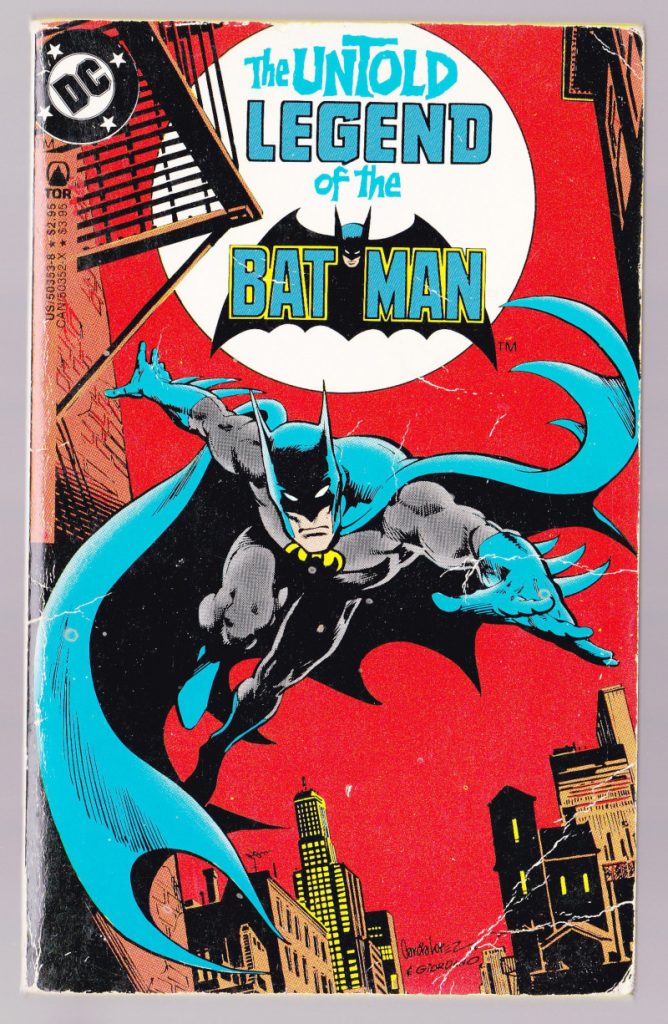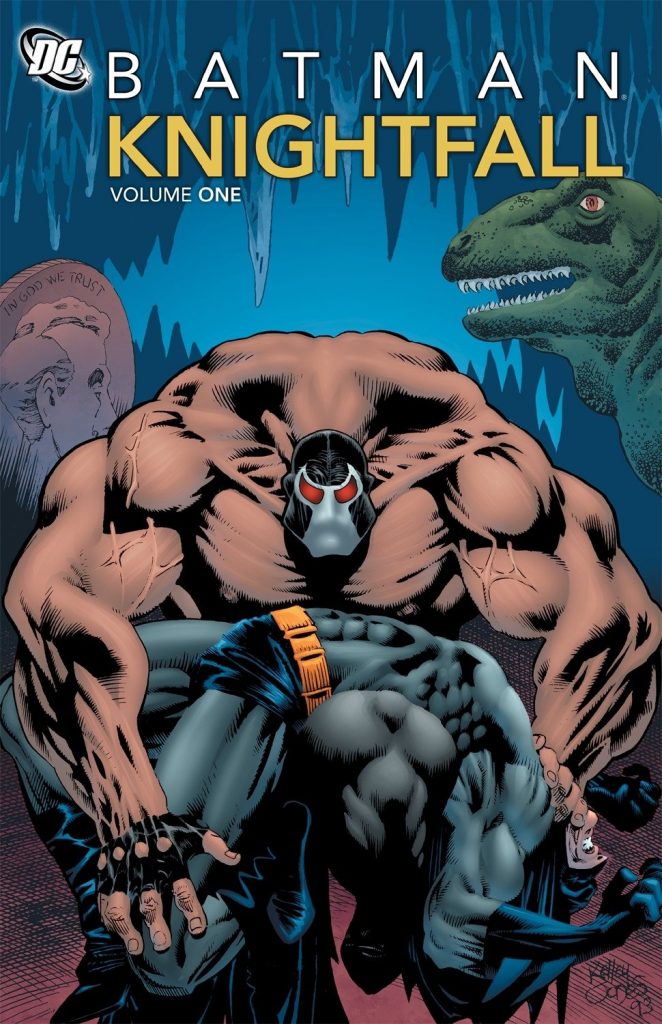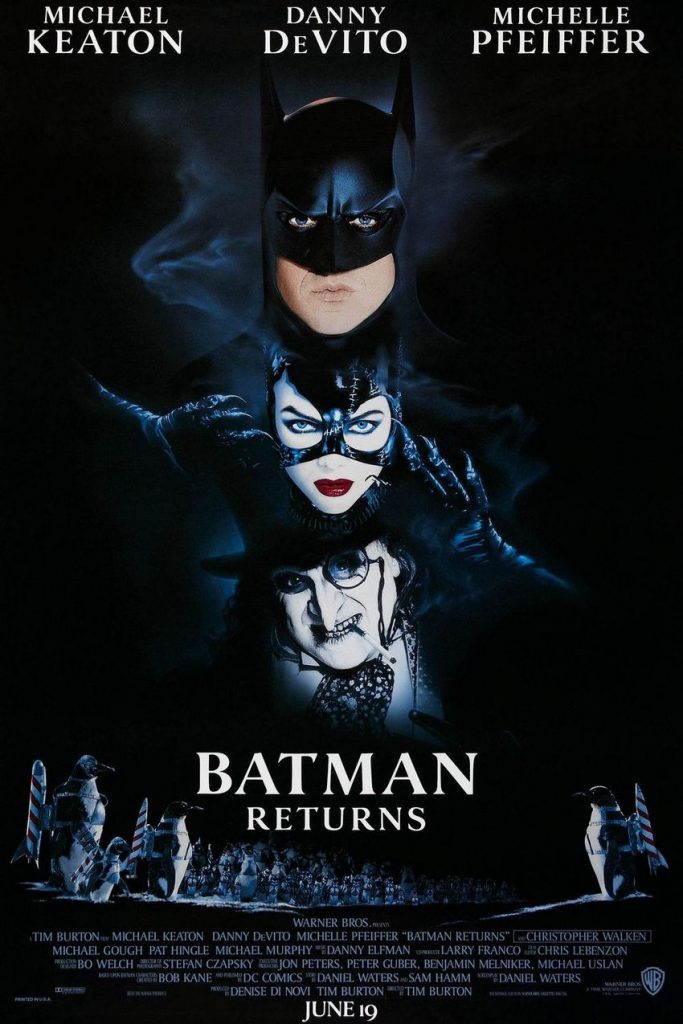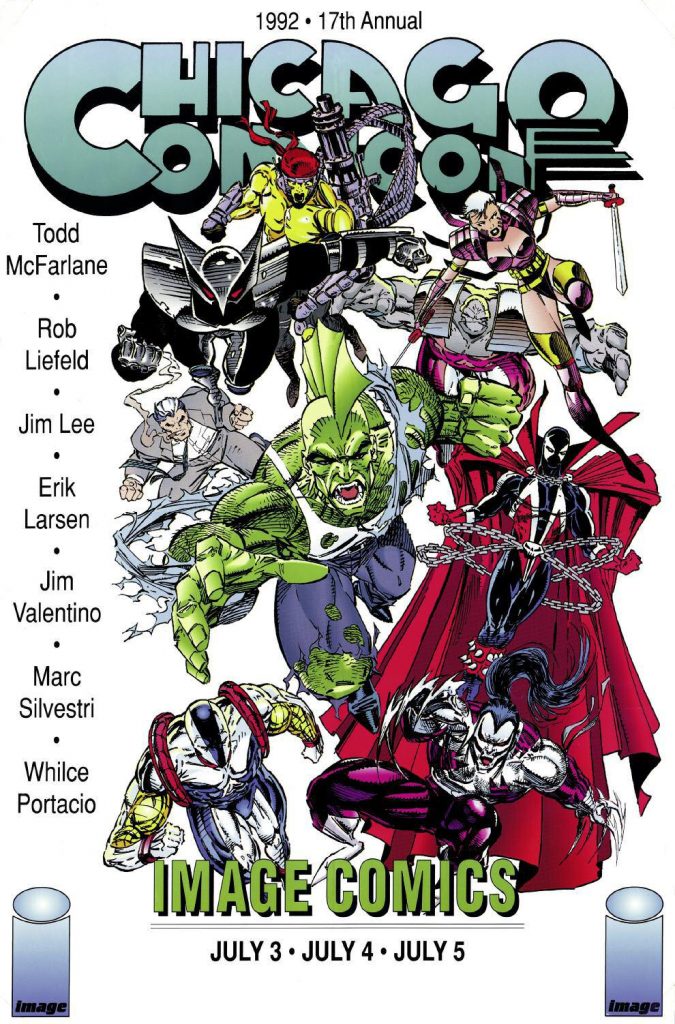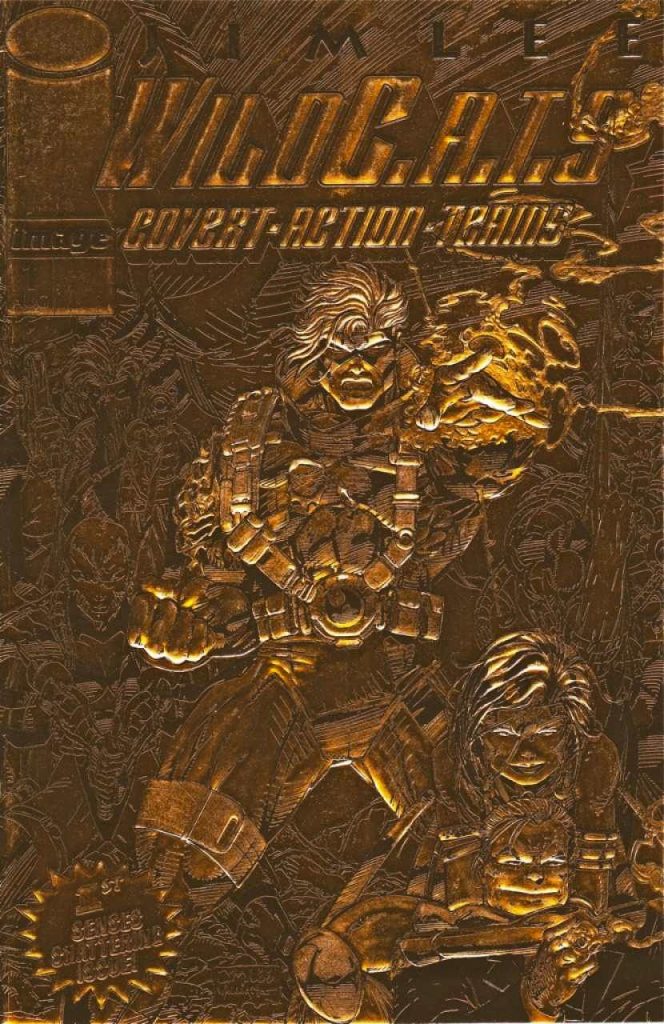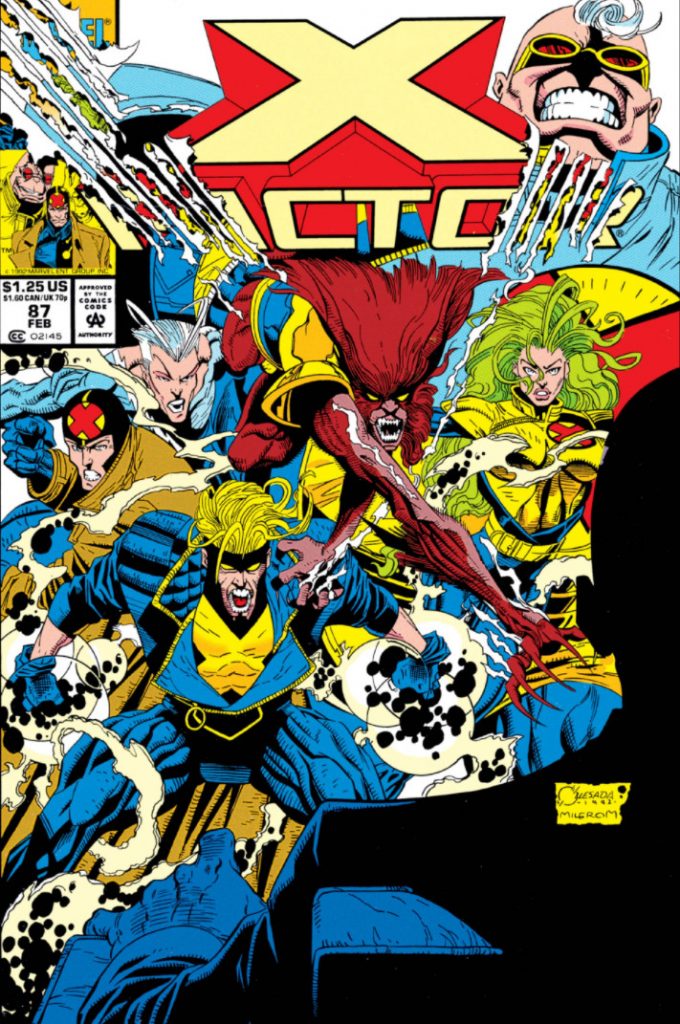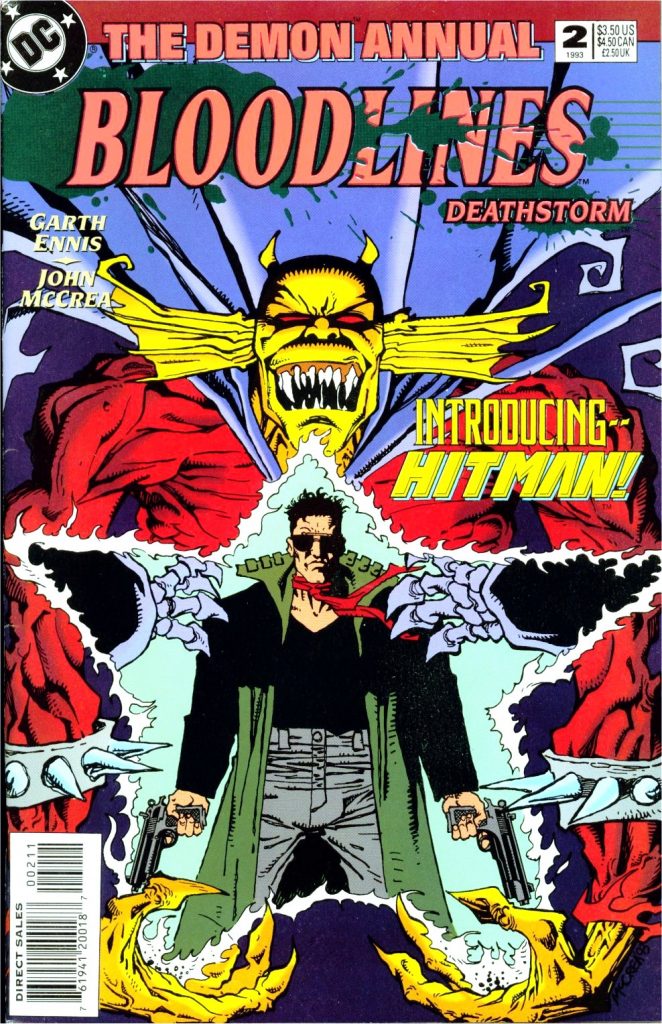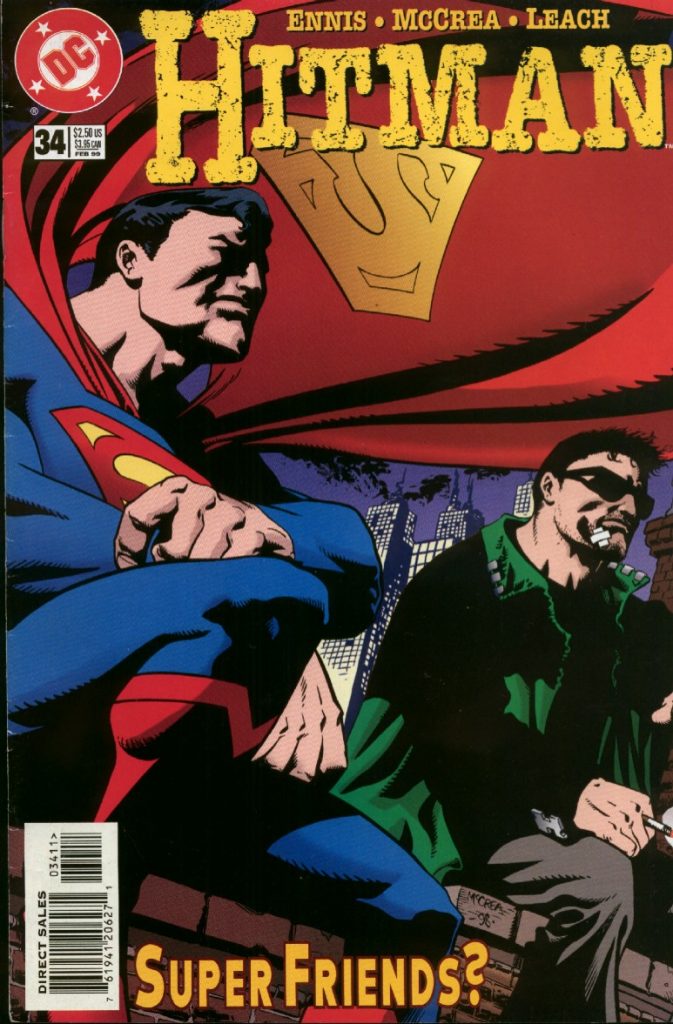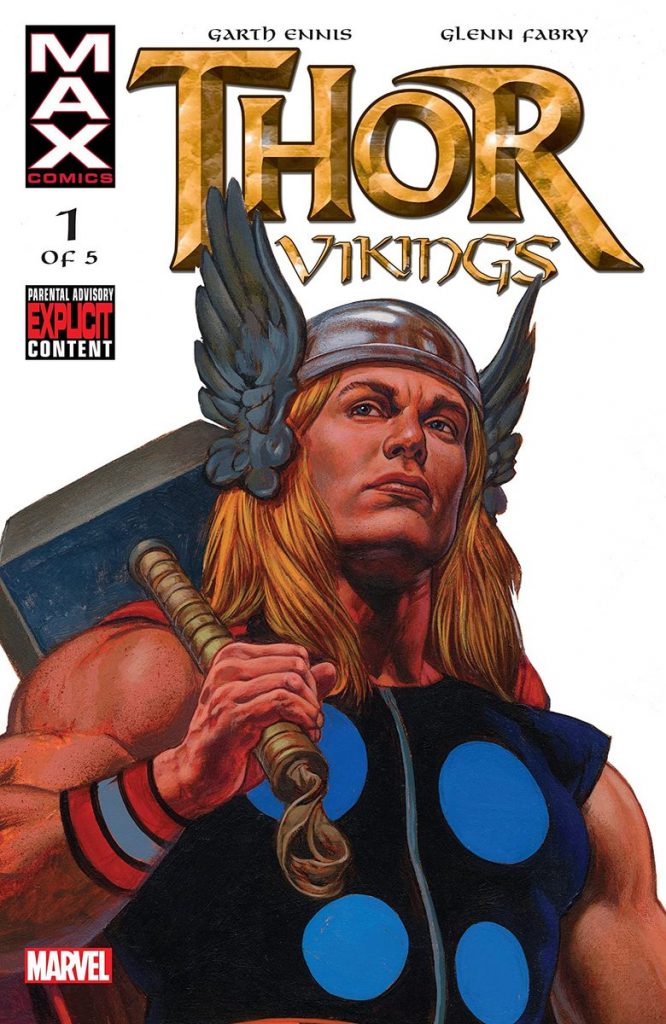The Comics That Made Them with Joshua Williamson
Let's dig into the inspirations of one of the biggest writers in comics today.
The comics you read and the comic experiences you have early on in your life often form the building blocks of your relationship with the medium in the future. Obviously what you’ll enjoy expands from there, but for readers, those earliest experiences can be enormously influential on you going forward. It’s the same for our favorite creators. Some of those foundational elements can define the interests or views of writers or artists in the future. This interview column is all about those, as I chat with creators about five of the biggest influences and inspirations from the time before they were working in comics. This is The Comics That Made Them.
In this entry into The Comics That Made Them, we’re joined by writer Joshua Williamson. The scribe of DC comics like Robin, the upcoming Rogues, and some little book called Batman as well as Image titles including Nailbiter and Birthright has had a busy few years, going from a seminal run on The Flash to the mountaintop with the aforementioned Batman. He’s doing strong, well-liked work already, and there’s a whole lot more to come.
I knew when I reached out to Williamson that he’d find some interesting wrinkles to bring to this conversation, especially after telling him that he could select anything, not just comics, as long as it’s related to comics. I was right. Williamson didn’t just choose five comics, but a stretch for a character, a huge moment for comics in the 1990s, a single issue, an experience he had, and a specific writer. It was a fascinating mix, and predictably, it led to a fun conversation about the unique inspirations he had on his path to becoming the writer he is today.
This interview is open to non-subscribers, so if you enjoy it, please consider subscribing to SKTCHD to support more work like it going forward. Also, it has been edited for length and clarity.
We’re going to start with Batman comics from the late 1980s and early 1990s Batman. I imagine this coincided with you getting into comics initially. Do you remember what your earliest Batman comics were?
Joshua: When I was a kid, my parents had already read comics. They had short boxes, but they had stopped reading at that point. My mom would talk about buying the original Teen Titans off the rack when she was a kid. That was her jam. My dad was much more into Fantastic Four or Doom Patrol. He was always into the more science-based characters. When I was a kid, it was kind of whatever comics were around. But I remember my mom got me The Untold Legend of the Batman. This is the first thing that I really started reading when I came to Batman.
I’ve never heard of that.
Joshua: It’s super weird. It’s drawn by Jim Aparo and John Byrne and written by Len Wein. It predates Year One, but it’s the history of Batman. It’s even stuff from when he was a kid. It was originally a three-issue series. What they did was they took that three-issue series, and they cut it up and made it into a book where its panels are turned into splash pages.
Oh my God. It looks like a novel.
Joshua: Dude, it’s awesome. They would basically break it up into these bits and pieces, and it’s the history of Batman all the way up to a certain point. It’s this weird origin story of Batman. It’s really good.
This is the first Batman thing that I remember, which also kind of warped some of my thoughts about Batman because there are certain things in this that are not canon. This is pre-Year One. This is pre-Crisis. I was just going in, I think, around the time that Batman ’89 came out. I was already into Batman because I was buying whatever Batman comics I could get my hands on.
And then you get around to 1992. 1992 is a big year for me with comics. Batman Returns comes out. Before that, whenever I wanted comics, I always had to get my parents to drive me to the comic store called Players. It was really far away. This new comic book store opened next to the movie theater the weekend that Batman Returns came out. They were like, “If you bring in your tickets for Batman Returns, you get a free dollar Batman comic.”
And that summer, I saw Batman Returns in the theater 17 times. I would go watch it, and then when the lights came up, I would walk up and down the aisles, I would find ticket stubs on the ground, and then I would go into the comic book store with this pile of ticket stubs. And they would be like, “Whatever.” I was just grabbing all of these dollar Batman comics and it was all this weird stuff. It’s that era between Jason Todd dying and Knightfall happening. That’s the era where I really started really getting into Batman. And one of the lucky things about that era was that Tim Drake was coming around. So, all of a sudden, it’s like I’m this preteen kid and here’s this new preteen kid who’s just gets to hang out with Batman and figures out who Batman is.
And then that fall was when the animated series starts. It’s this whole period of just intense Batman action. And then Knightfall starts immediately after that. I remember buying the issues leading up to Knightfall and not necessarily knowing what was going on. I was just super hooked into Batman. It was like this full-frontal assault, especially with the media at the same time. You have this three-year span of time with Batman ’89 and then Batman Returns, plus The Animated Series. It was this humongous stretch of Batman stuff, all the time. I was buying Batman comics like crazy, Detective, Batman, Legend, Shadow. Just getting everything I could consume for Batman in that time period.
I feel like during that period, there were two options you could go with if you were going to become a comic fan as a kid. There’s the Batman route, which you just described. And then there’s the X-Men route, which was based on the cards and the animated series, and then like the million Pizza Hut tie-ins that they were doing. And jumping in on the Jim Lee stuff and getting X-Tinction Agenda and all these different things.
That was the forks in the road. I went X-Men, you went Batman. Although, I will say, I was really in on Batman during that period. I actually think, and granted this is child brain still infecting me, but I feel like that Knightfall era all the way to almost like … What was the end? Was it No Man’s Land? Or was it Contagion after that?
Joshua: Oh, man. No, Contagion came before No Man’s Land. Oh my god, what was that earthquake arc called? Because you have the earthquake and you have Contagion, and then you have No Man’s Land.
I think that era hit hard. Especially when you were that age, because all those things seemed so insane at the time.
Joshua: Well, No Man’s Land is late ’90s, early 2000.
That is true.
Joshua: You’re edging out of the ’90s at that point. But you’re right. I was really into Batman. I really got into Superman around The Death of Superman. I guess it was in part about stuff being introduced at the same time because it was like Superman died, and all of a sudden here’s these four new characters. I got Superboy out of it, and obviously Eradicator, Cyborg Superman and Steel.
I’ve thought about this a lot lately. It allowed me as a new weirdo coming in to claim ownership of all these things. I had ownership over Tim Drake because he became Robin while I was reading. But on the Marvel side, my parents had just signed me up to a bunch of subscriptions. I was subscribing to four books at one point, and it was like Spider-Man 2099, X-Factor, Amazing Spider-Man, and then X-Men.
The problem with the subscriptions, though, is subscriptions are always like a month late from what’s actually coming into the stores. I would say I was like half a year into my subscriptions before I started going into the comic shop so I could get it on time. And also, those subscription comics would always come in these weird little bags and they would just roll them up. They would just shove them. I’m like, “These comics are thrashed.” Especially around the era of X-Cutioner’s Song, I remember getting X-Cutioner’s Song in the mail and being like, “These are thrashed comics.” I’m more of a DC person, but I know a lot about Marvel in the 1990s. Like I was saying with X-Men, I was buying a lot of it. But then by the time you get to ’94, I started working at a comic book store, that’s when it’s like, “I’m reading everything at that point.”
That on ramp of Batman in that time period, it really shaped my love of the character and my thoughts on it. I started really getting into all of comics through that. It starts off with Batman in that time period, and then it becomes an addiction where I’m just grabbing everything I can.
It was an interesting stretch for the line to, because the early 1990s led into the mid 1990s where you also had Tim Drake get his own book and then Nightwing in Bludhaven. I know Chuck Dixon is…let’s say the perspective on him has shifted quite a bit, understandably. But those were great books. Those were easy to get into. And the next thing you know, you jump into all these different things. It was easy to jump from Batman into a bunch of different things, because there were just so many different characters and they all went so many different directions from there. I do have to ask, though: were you pro-Azrael Bat or anti-Azrael Bat?
Joshua: I thought it was cool. It’s funny now when you look at it. You’re like, “Oh, there was clearly a progression of this thing.” Because he went from a blue suit, the armor to the red armor. And it was like, “Oh, here’s Azrael.” It was such an interesting progression with that character.
At the time, I liked it. I thought it was interesting. I wish that there had been … I don’t know this, so I can’t speak to if there was a plan or not a plan, but I would love to sit down with (the Bat office of that time). I’ve gotten to sit down and talk with Jurgens a lot about the Superman stuff and the process and what they were doing as this was coming out. I’ve never really gotten to sit down and talk to anybody who was working on Batman from that time period and be like, “What was the plan for Bruce?” Because Bruce stops being Batman, and then he goes and is in Justice League Task Force.
And all the Bruce Wayne stuff in there is him in a wheelchair traveling with this Justice League team. And I’m like, “What are they doing over here?” I don’t know for sure. I can’t say there wasn’t a plan, but I would love to know what the plan was with Bruce being not completely off the map. He’s over in Justice League Task Force.
With a broken back.
Joshua: Yeah, he had broken back, but there’s no … It’s a weird thing of, if this would happen now, there would be a new Batman number one, and then Bruce would be in Detective or Shadow. That’s how you would break it up now where you would have a Bruce Wayne book. It wouldn’t be Justice League Task Force #14. It was just dropping Bruce Wayne into this book. That book was already kind of a weird anyways. It’s like, “Who was reading that book? Well, now, it’s a Bruce Wayne book.” It’s such a strange thing. It was like him and Bronze Tiger. It’s supposedly a spinoff of Task Force X stuff. And then you drop Bruce Wayne into the middle of it.
What we would do with that now, if Bruce Wayne was going to go up against Bane, it would be such a different system. I would love to talk to somebody and be like, “What was the plan? How did the plan change?” There’s always the pieces. If you talk to Jurgens, they had a plan and they stuck to that plan. There’s little things that kind of filter through, but for the most part, they were like, “This is what we’re doing.” And it feels like it’s long, but The Death of Superman, Reign of the Supermen, Superman Returns stretch is actually not that long, realistically. It’s just that it was weekly.
Did you have a favorite from that period? Whether it’s the animated series or the movies or the comics? It can be any of them.
Joshua: Batman Returns is like our bond is at this point.
I mean, you saw it 17 times in theaters. That’s a lot.
Joshua: Yeah. Anytime there’s new merchandise from it, I get it. I always get Batman Returns merchandise. People at DC are well aware of this. The two movies are part of why I got the oval back in Batman. That was part of my motivation to be like, “Well, look at the oval, it’s iconic.”
I would say Knightfall, though, if I had to really think about. I think about Knightfall a lot. There’s a lot about Knightfall as an event that worked that isn’t as big and crazy as the events we do now. But that event shaped a lot of my thoughts on stuff that we do. That whole era of that event had a huge impact on me and my thoughts on events. So it’s probably Knightfall.
It seems like it did have an impact on you as a creator, though. If only because the oval and because of just like shaping how you view events as things that could work. It seems like Knightfall did work.
Joshua: That whole time period…I remember one time when I was in college, me and a bunch of guys were doing our laundry in the dorms. We’re doing laundry, and I remember it was me and this other guy whose name is James Lennon. He was very into Batman as well. And at one point, somebody came in and they were like, “You guys like Batman, right?” We’re like, “Yeah.” And he’s like, “What is going on in that book?”
That was a loaded question.
Joshua: We ended up holding court with 12 people in the laundry room as I told them basically everything that had happened in Batman comics from 1989 to 1999. Because it all runs into each other. When you really look at it, that era of Knightfall carries into the next one, and then you’re just like, “And now, this is what’s happening.” It was really funny to just go down memory lane of 10 years of Batman comics. I feel like I was able to really pull it off in that room. It was like my Ted Talk for Batman in the 1990s in the laundry room. That’s what it felt like.
So, next item on the list. You mentioned 1992 was a big year. One of the biggest reasons in comics was because Image was founded that year. What made that stand out to you? Was it about them all leaving at the time? Or was it just because you were really into the comics?
Joshua: No. I have a dark secret related to this. I was so anti-Image when Image started. Like I was…
Betrayed?
Joshua: Yeah, I felt betrayed. I was 11 and I was so into those books. I would say Jim (Lee) and (Todd) McFarlane particularly and then Rob (Liefeld), and then you kind of go down like the line, but it was Jim and Todd particularly. I couldn’t believe they would leave.
Also, I’m not getting the full story, right? I’m getting it from either Wizard Magazine or people complaining in the comic book store. People being like, “Oh, what’s going to happen now?” I think you and I have talked before about whether the complaining that the sky is falling in comics has been happening for like 40 years. It probably has been happening the entire time. At that time, I didn’t have internet access. You’re talking about 1992. I’m not able to go on and just straight up read the interview. I’m just getting what I could get from the comic store or from Wizard.
I remember all my friends read comics. I remember just being like, “Man, forget Image. Fuck them. I’m not reading Image. I can’t believe they would do this.” I was just shunning everything involving Image. And all my friends were super into it. They were just so into Spawn, so into Youngblood, but I was out on it.
And then we went to the comic book store and my brother bought Youngblood #4. And I was like, “Oh, this is trash.” And we were in the car driving home and I was like, “Let me see this trash.” And I started flipping through it and I was like, “Oh, this is fun and cool.” The next week, I wanted to see what I could get. And I remember getting a bunch of stuff. And then that year for my birthday and Christmas, my mom was like, “What do you want?” And I said, “I want Image comics.” My mom and my grandma, they went to Golden Apple, they went to Mile High and they bought me a year’s worth of all the Image books. But the main ones I wanted like Spawn, Youngblood, CyberForce, WildC.A.T.S.
It was just all this new stuff. This is also, I think, a commentary of what happens in comics every once in a while. There are typically these weird rotations where people want meat and potatoes, then they want new. And then suddenly, they come back around to, “Well, they want basics again.”
I was 11 or 12 years old. All this new stuff, all these new universes and all these new things where it was like … At times, when I would look at Marvel and DC, there was such a huge backlog. It was such a huge daunting task to understand a lot of this stuff. But with Image, it wasn’t like that. I remember I got really into just all of it, just all of it, like Brigade and Bloodstrike and New Men. Whatever it was, I was getting it.
I remember one day being at school, talking about WildC.A.T.S. and talking about New Men, which was written by Eric Stephenson and drawn by, at the time, Todd Nauck. I remember talking to one of the guys and he was like, “Man, just like two months ago you were like screw Image. Now, you’re like Image is my thing.” They were making fun of me about it. “Now, you’re like all about it?” And I’m like, “I don’t know. I saw the light.”
I remember one guy I went to school, he had that WildC.A.T.S. #1 that was like a gold edition of the issue. And he had kept it in Mylar under his bed. He was like, “This is the most valuable thing in my life.” I remember he pulled out and showing me all of this. He had the gold edition of WildC.A.T.S. #1.
I traded a very valuable Magic card that I got at Wizards of the Coast when I was a kid to my comic shop for a copy of Deathmate: Black.
Joshua: Oh, really?
The first appearance of Gen¹³. I was ride or die with Gen¹³.
Joshua: I have never read Deathmate.
You probably shouldn’t.
Joshua: I want to though. I’m fascinated by it. I remember I was really confused by it when it was coming out because I wasn’t a Valiant person. And also, it was hard to get. It was all irregular. And didn’t they come out of order or something like that? There was some kind of a problem with it.
It was very confusing.
Joshua: I think when it came to that era where there was all these new things popping up, like Legends with Dark Horse and Valiant. But Image, I think it was just the energy of it and the newness of it. I got the most into the ones that were consistent. Spawn and Savage Dragon came out so consistently that I got really into those two. I was very much a Savage Dragon and Spawn person. I read Spawn probably until the 100th issue.
This also helped me go from “I’m addicted to this” to “I want to do this for a living.” Image unlocked the idea that I could make these. And then you start hearing stuff and reading Wizard and then going to comic store and being like, “Oh, there’s a bigger world than just Marvel and DC.”
I remember when I was a kid, I had a very small walk-in closet, and I basically turned that walk-in closet into my comic reading room. Marvel used to release those poster books. I would take the staples out and I would wallpaper it with those books, and then whatever posters I could get my hands on. And then behind that, I had this shelf. I remember that on this shelf, I had my Marvel stack, my DC stack and my Image and others stack. If I ever got like a Malibu Comic or something, it would go there. But it’s funny to think back about like that’s my humble beginnings in comics was this one shelf.
It seems like it was the thing that unlocked that you could do these yourself, which is a really big thing. Because obviously, you are currently doing that. When you were a kid and once you finally saw the light on them, did it make you not only want to make your own comics, but eventually release something in Image too? Was that something in your brain where you were like, “This is a bucket list thing.”
Joshua: Oh, yeah. Doing an Image book was a huge bucket list thing at that point. It becomes this weird thing about ownership too. Because with Image, those guys were already legends to me. And being able to see what they were making, it made me feel like, “Yeah, I can do this. “
I remember reading an article, like, “Well, if you want to break into comics, you got to go to a convention and have a pitch.” And so my friends and I, we found out we were going to go to this thing called the Shrine Convention in LA. We just thought it was like a convention with the editors there. And so, we’re going to go pitch with the editors.
We stayed up all night drawing our own comic book characters and making up ideas. Very much an Image energy. I still have some of those drawings somewhere. We went there and it was not really a…it was more of a swap meet. So, we’re just looking at stuff and buying comics, toys, and other stuff. And they had a couple panels about whatever movie was the thing they were promoting at that month. It was not the kind convention you go to when you meet somebody.
For me, I think my friends were disappointed in that. They were like, “yeah, whatever.” But I was like, “I’m still doing it.” Then I started going to San Diego Comic Con. When I started going to San Diego, that’s when it was like, “Oh, I can actually walk up to somebody.” And I would go to the Image people and I would bug the crap out of whoever I could and ask them questions. I would go to all the creators I could find and ask them questions.
But then you have this turn where it’s like you get closer into the late ’90s and going into the 2000s where now I’m older. But again, a lot of those Image creators were already, I think, in my mind, legends. But then I got to watch people like Brian Michael Bendis come up. I think being able to take ownership of not only of these characters that were new in this whole universe they were building, but also the newer creators that were coming in…it really made me realize, “Okay, I can do this.” I really want to make comics.
Let’s talk about the next one. It’s X-Factor #87 by Peter David, Joe Quesada, Al Milgrom and your boss, DC’s Editor-in-Chief, Marie Javins coloring it. This is a very famous issue. It’s the one where the whole team gets a psyche evaluation from Doc Samson. Why did this make your list?
Joshua: I remember when I read it, it just unlocked something in my brain about what a comic could be. Even when you’re talking about the Image era, it was always very big and loud. Everything was big and loud. I started reading X-Factor with my subscriptions. I don’t know why X-Factor. It might have just been because of Peter David. I was already reading stuff from Peter David a lot. Because Peter David was doing…
Incredible Hulk.
Joshua: He was doing Hulk. I mean, you’re talking about this era where he was doing Hulk, Aquaman, Spider-Man 2099 and X-Factor at the same time. And those were some of my favorite books at that time. I remember sitting down to read that. It’s the issue right after X-Cutioner’s Song. I loved X-Cutioner’s Song. But then, suddenly, there’s this one-off issue. I think at that time, a lot of comics were just big and loud, explosions all the time, at least to me. And all of sudden, there’s this issue where they’re just talking, and they’re talking about their characters, and why they do what they do.
That book, it covers a lot of ground in just those few pages. You get to have this understanding of, “Okay, this is why Strong Guy does what he does and why he acts the way he does. This is why Multiple Man acts the way he does. This is why Rahne acts the way she does.” And then he gets to Quicksilver.
So good.
Joshua: It’s just this definitive statement upon his character that shapes everything we know about that character since. All the stuff with Polaris. It was such an interesting psychological breakdown of the characters.
One time, I was chatting about writing with Scott Snyder, and he was like, “Well, we don’t want to get on the couch too much.” And I was like, “What do you mean get on the couch too much?” “Well, every once in a while, the characters have to sit on the couch and talk to the therapist, basically. That’s kind of what happens in your scene or whatever.” And I was like, “Well, I love stuff like that.” I think that comes from that issue where that literally happens where they get on the couch and they talk to a therapist.
All of my books since then are influenced by that in some way or another. It’s funny. I announced that I was doing Rogues, but the Rogues are actually a group of characters I would love to have go to therapists and just go through a similar situation. I think X-Factor #87 just unlocked something in my brain about what a comic could be and how it could be different than what I was used to.
I think for people who are older than me, the book that did that was Watchmen or Dark Knight Returns. But to me, those were all in the past. There’s a lot of these big books to me came out before I was reading books all the time, where you’re told this is a big deal.
When someone is handed Watchmen now, it’s this understanding that Watchmen is this elevated piece of the art form. It’s this humongous thing. It’s been movies and TV shows. So, when someone hands you Watchmen now, it comes with a lot of weight. It comes with, for lack of a better phrase, baggage. There’s an expectation around it.
When you’re able to buy something off the rack, sit down with zero expectations, and just read it and be like, “Whoa, this is not what I was expecting at all,” that’s incredible. And again, it comes to the idea of ownership. That book for me was that moment of, “This book is this funny book. It was the funny X-Men book.” And then suddenly it was like, “Well, no, here’s this very serious issue.” It was done in a way that really made me realize, “Oh, this can be different.” So, it’s something I always look back at. I’m a big fan of Joe Quesada. I actually have some pages from that issue.
Really?
Joshua: Yeah. The first time I found them was at New York Comic Con and I thought I was going to black out. It was one of those things where you’re searching and suddenly you find a page of a comic that’s 30 years old. I got the pages in probably 2012 or 2013. So, it wasn’t the original art market of today. It wasn’t as crazy as now.
To be able to be at New York Comic Con and find somebody who had two pages and they were like 150 each, I was shocked. And then I had Peter David sign them. I’ve met Joe Quesada, but I haven’t talked to Joe in probably like 20 years. If I ever got to sit down with him, I would probably fanboy out a little bit and just be like, “We should probably be talking about work stuff, but you should sign this for me.”
One time, Marie (Javins) and I were having this conversation, and this issue came up and I was talking about it in terms of what I wanted to do with something. And then Marie said, “I colored that.” I was like, “What? Did you really?” And I had it on my desk. I flipped it and like, “God, you totally colored this.”
There are two things that I think are really interesting about this. It’s one of the first superhero comics I remember reading where it really felt like it was about the people and not the super people, if that makes sense. The other is something that came up when I was talking to Chip (Zdarsky) for one of these interviews. A lot of writers seem to enjoy one and done stories and that a lot of times a specific comic builds that connection. Like for Chip, he loves the Amazing Spider-Man Annual #20. Do you feel like this built an affinity for standalone comics for you?
Joshua: Yeah. I was really a big fan of annuals too. Annuals were always one and dones. Or DC would do those Prestige format one shots. I loved that stuff. And actually, when I sold my collection, I kept most of the one shots and annuals because I just really liked that stuff.
I remember there was a moment where DC would do on Batman books. They would advertise it was a one and done with a little logo on it that said one in one on it. I was always like, “Hell, yeah, give me more of those.”
There was a time not that long ago when I was living across the street from a comic book store, and I would go in there and be like, “Is there something that’s just a one shot?” I love stuff like that. I wish we did more of that. I think the market is opening up more to things like anthologies and the one-shot anthologies that DC and Marvel are doing. But I would love the more one and done type stuff. There’s a whole rabbit hole we can go to about that stuff with one and dones, why they work and why they don’t work. I think it did make me want to do more of it, because they are very focused. There’s something very focused about just being able to say, “I want to tell this story in this amount of room.” I have one thing I want to say, or one point to get across, or one thing I want to do. When you’re not trying to lay out a million A, C, D plots.
But then you look at something like Vengeance of Bane. Vengeance of Bane is an awesome one shot. It’s perfect, but it’s also prelude to a humongous story. And yet, it works so well as a one shot. You can just read that one and know everything you need to know about Bane in one issue.
I really do like a lot of one-shot stuff. But there’s something about X-Factor #87. I think it just kind of unlocked my brain on what I could do differently with it. And again, that’s when I was starting to really figure stuff out of like, “I want to do this. I want to make comic books.”
I think it’s important when you find a comic that expands your idea of what they’re capable of. I remember when I was a kid, I thought superheroes were every comic. I read comic strips. Calvin and Hobbes and Bloom County were a big deal to me, but they felt like a different species. But then when I read Bone, I was just like, “Oh my god, this is a comic that’s kind of like a comic strip, but it’s its own thing.” My idea of comics started expanding.
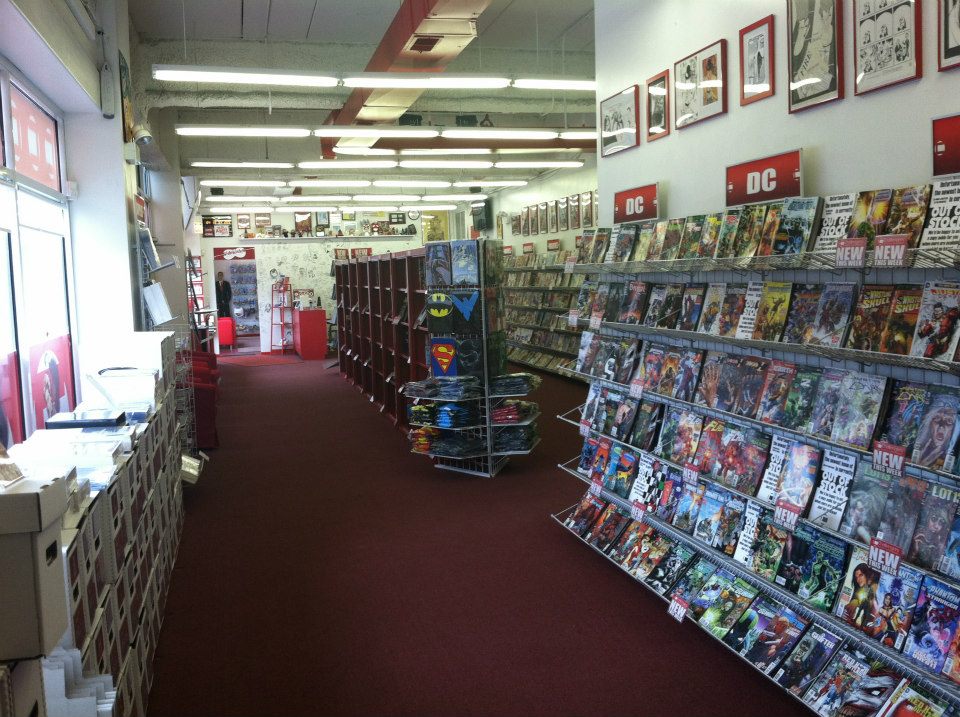
Let’s move on to the next subject, though. I feel like the final two are kind of connected, but I want to start with the comic shop side of it. You worked in a comic shop. You said that was one of the biggest influences/impacts for you. We’ll start with the basics. When did you work in one and what was the shop?
Joshua: I started working at a comic store called Comic Castle in 1995 when I was 14. What happened was I became that annoying kid in the comic book store who was there all the time. Every Saturday, I would always go into the comic book store and just bug people that worked there. During the summer, I was there every day. I was around 11 years old and I was a very independent child, I’ll say. I would go to Pizza Hut, play NBA Jam, buy a personal pan pizza that usually had, at that time period, the whole X-Men promotion. There was all this Joe Mad art everywhere, which is amazing. I would play NBA Jam. I would sit there and eat my personal pan pizza, and I would buy a comic book at the comic book store. And I was there reading my comic.
I was there every day, bugging the crap out of them. And at one point, the owner was like, “Here’s what I want you to do. I want you to open these packs of WildC.A.T.S. cards. I want you to make a set and I’ll give you a free comic” And I was like, “Hell, yeah. Let’s do this.”
And then that shop closed. They opened a new one with a new manager. I used to go in there every Saturday morning and my mom would drop me off and I would just go into this comic shop and read comics, buy comics, just bullshit with the manager. And then one day, the manager was like, “Do you want to work here? I’ll pay you under the table. Do you want to work here?” I eventually worked Saturday and then I would work Wednesday nights. I would work at this comic shop like two days a week.
I worked there from 1995 until 1999, basically throughout high school. At that point, I was just reading everything. I was reading every Marvel and DC book and everything that Image was pumping out. That’s where I discovered Vertigo. I remember Invisibles #1. We had it behind the counter because it had the ‘F’ word in it, so we weren’t allowed to have it out. I remember when that came out, I remember getting Kill Your Boyfriend and starting to get more into Vertigo.
When I went to college, I went to college in Long Beach, California, and I got a job. I remember, I would go to this comic book store, it was called Amazing Comics. You started talking to people that work there, because I’m college age. All the guys that work there are all similar ages to me. I went on a Sunday afternoon and the employee had called in sick, and the owner was by himself. The shop was huge. At the time, it was one of the biggest shops I’ve ever seen. It was ginormous.
Somebody asked a question about Superman. They were asking questions and the owner couldn’t help them find the issue. He just didn’t know. I was like, “Well, I know.” And I went and I showed him. The person I helped bought a stack of Superman comics because I was able to help. I had turned in an application a few times and never heard back. After that, he called me. And I remember on my application, I wrote, “I know everything about comics. I dare you to ask me a question.” I was a very cocky kid. This is part of why I think Damien (Wayne) and I get along so well. I was a very cocky, headstrong, arrogant kid, and even worse so when I was in my late teens, early 20s. And so he called me and he was like, “Do you want to come in for an interview?” And I told him, “Yes, I do.”
I came in for the interview he told me the hours he needed, which worked for me. And then he was like, “Well, I have a bunch of questions for you.” His questions were … I don’t remember them all, but I remember one. But he had all of these very ranging from nerdy to specific. Like first appearances. He’s like, “What’s Gambit’s first appearance?” And I’m like, “Well, technically, it’s 266, but there’s also Uncanny X-Men Annual #14.” He had all these things that he’s asking and at the end, he was like, “Alright, I have one last question to ask of you.” And I was like, “All right, what is it?” And he is like, “How old is Peter Parker?”
Oh, shit.
Joshua: And I was like, “Well, I don’t know.” No one knows for sure. But we started breaking down how old I thought he was. And my reasoning for how old I thought he was, “Okay. Well, he’s out of high school. He’s been to college. He had done enough that they always said he should have graduated college. At that point, he was just considered to be a college dropout, but enough time had passed.” So, I was like, “I think he’s probably 26 or 28.”
And the owner did not agree with me. And we got into this whole thing of how old Peter Parker was, but I got the job. I think part of it was because I could have a conversation about it, but I also wasn’t confrontational. He hired me on, and I was there for a while. I was the manager for about the last eight months of that store. And then I ended up quitting. I basically worked at a comic shop for 10 years. I remember it was 1995 to 2005.
Do you feel like you learned a lot from that time working at shops?
Joshua: Working at a comic book store, I learned a lot about the market from people coming in and talking all the time. I remember when Marvel filed for bankruptcy and walking in the comic store and being like, “Wait, does that mean comic stores are closing?” Having realizations of what that actually means and reading all this stuff and then going to conventions and meeting people through that. The comic shop that I worked at in college was really interesting, because when I was in college, a lot of creators shopped there, editors shopped there. People from different movies and TV. People who worked in animation.
I would talk to them and I learned a lot from that process. That’s a part that was such an invaluable resource, because I was just in it all the time. It really shaped my understanding of the market side of the industry, even if it is way different now versus then. But all those people that would come in, all those creators, and it gave me a much more…I don’t want to say a more grounded point of view of our industry, but I have a much more in the trenches view of it. Because I was there. I saw what actually sold and what goes into selling. It just shaped a lot of it. Even with pitching.
I remember this guy who worked for Vanity Fair. He was an entertainment editor for Vanity Fair, and he asked me to pitch him because he knew I wanted to be a writer. I shared my pitch, and as I’m pitching it to him, he goes, “You’re out of time. That sucks.” I was shocked. He said, “That’s how it really is. And you should prepare yourself for that. You need to be able to be faster.”
Being in a comic store and having to hand sell books to people, you start realizing how little time you have to hand sell to somebody. And that became embedded in my understanding of how to sell my own stuff and pitching in meetings. That’s why a lot of my work is very … Not all of it, but some of my books I can boil it down to a sentence because of that process of being there. A lot of people that worked at the comic book store also wanted to work in comics. You’re bouncing things off each other. I met a lot of like either artists, or writers, and editors do that process and being able to have opportunities to pitch people because of that.
I’m not sure how much later it was, but John Layman was still an editor at WildStorm at the time. He was a customer. And he was like, “What’s a book you would want to do for WildStorm?” And I was like, “I want to write Stormwatch.” And he was like, “Alright, send me your Stormwatch pitch.” And I had this 30 page Stormwatch pitch I had been working on, because I really wanted to do it. And I remember emailing it to him, and an hour later, he wrote me back and all he wrote was, “Fuck you, I’m not reading that.”
(laughs) That sounds like John.
Joshua: It’s a very John thing. But I mean, that’s working in a comic book store, being around the books on the marketing side, but also meeting creators. This can get to the fifth subject. It introduced me to a lot of stuff that I did not know about before.
That’s what it seems like the biggest impact was. In a lot of different ways, it expanded your worldview as to what comics really are and all that they’re capable of. It seems like it helped you understand how it really worked, but also they expanded your worldview about what comics really are. For example, it introduced you to Garth Ennis, our fifth subject, right?
Joshua: Yeah. I think the first thing I read of his was a Bloodlines annual.
The Demon with Tommy Monaghan.
Joshua: Yeah. That’s the first appearance of Hitman. I learned recently that Hitman was originally green lit to be a book first. And then DC was like, “We have to find a place to introduce him. Can you give him superpowers and then we can introduce him as one of these people in Bloodlines?” And Garth was like, “Whatever, fine.” And he did it in The Demon. That’s why Hitman even had powers. Because when you read Hitman, it’s awesome how much Garth Ennis completely forgets that he has powers. Even Tommy does. There’s moments where Tommy forgets he has powers over the course of that book.
I think the only real consistent way that it’s indicated that he has those powers is that he wears sunglasses all the time. Like…all the time.
Joshua: All the time.
That’s basically it. I do want to say, I think it’s funny…I’m not besmirching the people who worked on it, but Tommy is literally the only good thing that came out of Bloodlines.
Joshua: You don’t like the Psyba-Rats or whatever they’re called? 1
Did any of those characters show up the second time after that?
Joshua: Yes, of course. Argus was in Flash after that.
Okay, I forgot about Argus.
Joshua: Well, there was the Bloodlines miniseries. They had Ballistic and Loose Cannon, and that was a thing. I think Argus is the one that had the most real appearances. I’ve tried to sneak Argus into so many books and it never works out. He originally was in Justice League vs. Suicide Squad. In one of the early drafts, I was going to use the original version of Argus before he got his powers.
You really do know everything about comics.
Joshua: I know too much. But with Bloodlines, that’s appealing when you’re a kid and there’s aliens in it and a bunch of new superheroes. James (Tynion IV) and I talked about this a lot. This was part of the reason James was like, “I’m going to introduce a bunch of new stuff in Batman because introducing new things is so much fun.” Yeah, Hitman is clearly the winner of Bloodlines. Every time these initiatives come around and we’re like, “We’re going to introduce a bunch of new heroes,” Hitman gets brought up because it’s like, “Oh, you just have to get that one winner.”
I remember reading that Demon issue and I just loved it. I went and I started getting Hitman after that. The shop’s manager was like, “Oh, you should read Preacher.” And then I started reading Preacher. And then I was like, “What else has this guy done? I’m going to buy all of it.” Even when The Darkness came out. But when Preacher was coming out, I really just had this feeling of, “This is the kind of writer I want to be.” I really wanted to be like Garth Ennis.
And not just the idea of … I remember I was at that convention where Darick Robertson famously, or infamously I guess I should say, said that The Boys was going to out-Preacher Preacher. Did you know that he said that?
No, I didn’t. Although in some ways he’s right.
Joshua: In some ways he’s right. I asked Darick about this later and he said he regretted saying that, because at the time, Preacher had a reputation for being super gross. There were always gross things happening in Preacher and always this brutality of it. But when you read Preacher, it’s a much more of an emotional story. I’ve been rereading it now. This is part of why I added his name to the list. I’ve basically been rereading everything Garth Ennis has done this last year, but I started with Preacher, and I still haven’t finished it.
I’ve reread Preacher so many times, but when the Cassidy stuff starts to come around again, I get very … I have to take a break from it, because you get so emotionally invested in those characters.
Are you talking about his past, or the part where he betrays them?
Joshua: Well, I haven’t got to the past yet, but the stuff where he basically starts drugging Tulip essentially. And he lies. He lies about Jesse’s last words and that shit just drove me crazy. All that stuff where he was like, “I’m in love with Tulip and all that.” And obviously, there’s a lot going on there. I always fall off around that a little bit and then I’ll come back around and pick it up.
I just reread all his Punisher. I finished reading Punisher Max last week. I reread Hitman two years ago and I’m probably going to be rereading it. Hitman is the more fun reread out of the three of them, I think.
Hitman has aged so well.
Joshua: It has a dark ending. But it is a perfect comic. A few years ago, I was driving from a hotel to a convention with Peter Tomasi, who was the editor on it. I asked him all these questions about it because it’s perfect. It has this amazing story engine where he just gets a job and has to go on a job. It’s so clean and easy, but it’s fun, emotional. And the characters are so strong.
Even now, rereading Punisher while working on Batman, it made me think a lot about my voice for Batman, because my voice for Batman going back to what we talked about before, Michael Keaton’s voice is always Batman’s voice in my head. I mean, Kevin Conroy a little bit. But there’s something about Michael Keaton’s voice. And Michael Keaton would talk about how when he got the scripts for Batman Returns, he went through with a red marker and was crossing out lines, because he said, “Batman wouldn’t say that.” He was like, “Batman is much more quiet.” That’s why my Batman is very quiet and shorter. My Batman doesn’t make speeches. I try to keep him to very short clips.
And when I go look at Garth Ennis’ Punisher, his Punisher is the same. It’s very short clips. Rereading Ennis, it stands out how much his influence has been on me as a writer in terms of pacing and in terms of the character stuff I try to accomplish. It isn’t a mimic though. You have creators that are mimicking a creator a little bit. I don’t really feel like I mimic him at all, but there’s things where I’m like, “Oh, this is why I write dialogue the way I do.” I don’t like a lot of dialogue and panels and things like that. That all comes from reading this stuff. Everything Garth Ennis has done; I think I’ve enjoyed.
I was reading a thing with him recently where he was talking about how he doesn’t dislike superhero books, which I think is what people think. He doesn’t like the stranglehold he felt it has on comics. It feels less like that now, but it’s still a humongous part of our market, especially when it comes to the direct market.
I think it’s a much smaller part, but it sucks up a lot of the oxygen. I think the interesting thing is…from what I understand, Ennis doesn’t love superheroes, but he might like superheroes if he can find his own angle to it. And that’s the thing about Hitman that works so well. Take the e scene with Superman, or even the whole issue with Superman. 2 That’s a perfect example of Ennis’ superhero work. It’s The Cauldron through and through, but Superman still fits. Honestly, it depicts the very idea of what Superman means about as well as anything has in the last 30 years in one issue.
Joshua: That’s a done in one issue.
It is.
Joshua: Oh, man, that issue was so good. That’s one of the best issues.
It also ends with Tommy being like, “Oh, that was a hell of a thing.” And then shooting someone, I’m pretty sure.
Joshua: Yeah. He shoots somebody. He waits for Superman to go and he shoots the guy. It’s so funny.
Garth is interesting to me, because if you look at all these creators who … I’ll look at Grant for a moment. Grant was also a Vertigo creator who then was able to find footing in superheroes in a lot different of different places. A lot of creators are like that. They came in through Vertigo or came to do stuff in the 1990s who then found their footing in certain places. Grant obviously with Batman, Justice League, X-Men, and All-Star Superman. A lot of creators, they kind of stake these weird claims on things. And the only thing that Garth Ennis really stuck a claim on was Punisher.
There’s no Garth Ennis X-Men run.
What the hell would that even be like?
Joshua: What would that even be? That said, I was never a Thor person. I have weird blind spots in comics. There are certain things that I didn’t really get into, and Avengers was one of them. But there’s this Thor story that Garth Ennis did called Vikings.
I’ve never heard of that.
Joshua: Oh my God, dude. It’s called Thor: Vikings. It is awesome. You should read it. It’s actually the thing that made me like Thor. It was Ennis and Glenn Fabry did it. It’s a Marvel MAX title. I love it. It’s what made me really like Thor. There’s a part where Thor hits this viking, and because he’s hitting him with the hammer, he can’t destroy the hammer, but it messes up the viking’s hand when he’s doing it. And I remember being like, “Oh my god, this is so cool.”
Garth Ennis is fascinating to me. He never really went out and took a claim anywhere else. I did get to meet him a couple times. I read Donny Cates on his Substack and he wrote this whole thing about the two times he met Garth. It was so funny because they basically are the exact same two experiences I have with Garth.
The first time was at Emerald City Comic Con. We’re outside the Sheraton and we were all standing there and then Garth Ennis came out. And somebody introduced him and I was just quiet, because I was like, “What am I going to even say to this dude?” I don’t want to be that guy that suddenly is in a group of people, where it’s like, “I’m just going to fanboy out to you. I’m going to be that person.” And I didn’t.
But then around 2018, I was in a bar with a bunch of creators, and we were talking and having a few drinks. And then Frank Tieri sat next to me and Frank was like, “Do you want to meet my friend, Garth Ennis?” And when I turned around Garth was right there. And I had a few drinks, and I was, “You know what, when do you actually get an opportunity to tell someone you like their work?” I know it can be uncomfortable sometimes for people. I’ve met creators who I really liked, and I found out they will tell them they like your work. But I straight out was just like, “Fuck it.” And I just went into it. I did the whole spiel about how much he meant to me, all his work.
So, here’s Garth Ennis going to the bar, hanging out with his friends and all of a sudden, he has some dude just going on about him. I remember I could see Frank Tieri’s face out of the corner of my eye just like, “No, no, no. What are you doing? Stop. You’re embarrassing me.” That kind of thing. But I was lucky. Garth was very nice. I hope he doesn’t remember it.
It’s funny because sometimes I’ll be talking to Marie (Javins) on the phone about something at DC and she’s like, “Oh, I’m about to meet Garth Ennis.” And I’m always like, “Tell him I love him.”
Thanks for reading this feature interview with Joshua Williamson. If you enjoyed it, please consider subscribing to SKTCHD to support more work like it going forward.

